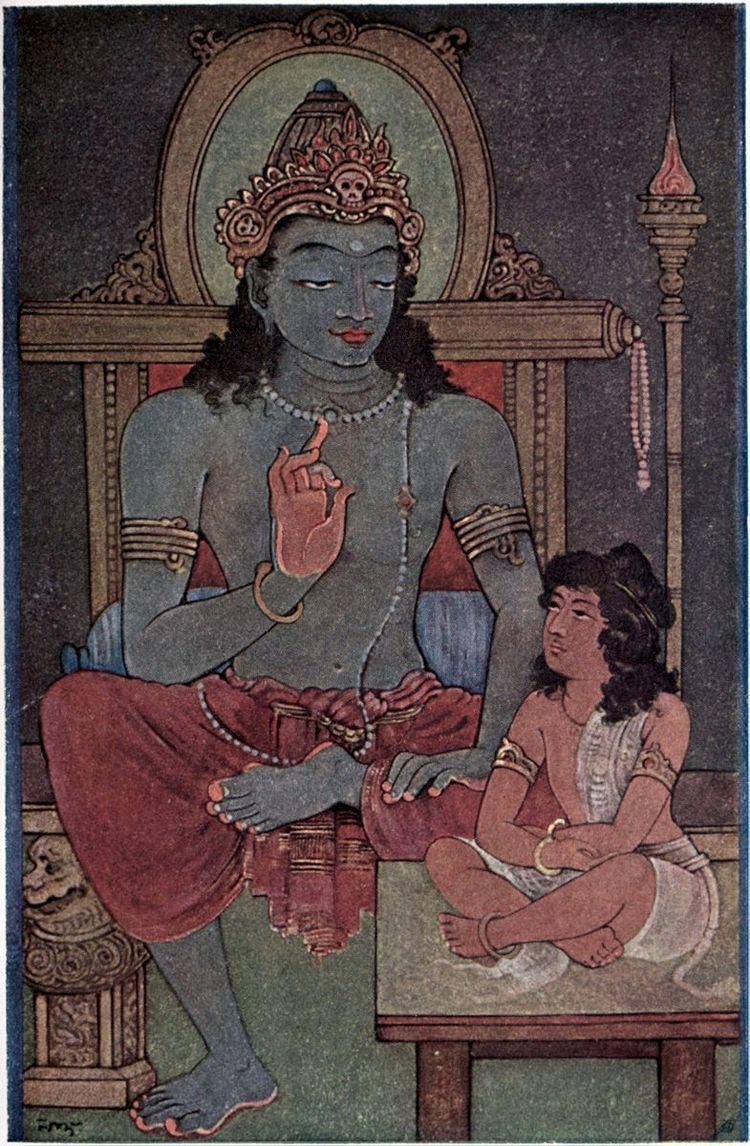 | ||
Kriyā (in Sanskrit "action, deed, effort"(in Tamil /ˈ/Kiriyai)) most commonly refers to a "completed action", technique or practice within a yoga discipline meant to achieve a specific result. Another meaning of Kriya is an outward physical manifestation of awakened kundalini, such as a spontaneous body movement related to Kundalini energy flow. O KriyaShakti is "a power of thought" said to be greatly studied by yogis.
Contents
Etymology
Kriyā is a Sanskrit term, derived from the Sanskrit root, kri, meaning "to do". Kriyā means "action, deed, effort". The word karma is also derived from the Sanskrit root √kṛ (kri) कृ, meaning "to do, make, perform, accomplish, cause, effect, prepare, undertake". Karma is related to verbal proto-Indo-European root *kwer- "to make, form".
The root kṛ (kri) is very common in ancient Sanskrit literature, and it is relied upon to explain ideas in Rigveda, other Vedas, Upanishads, Puranas, the Epics of Hinduism. The root "kri" also appears in the word Sanskrit, to imply a language that is "well made".
Bhagavad Gita
Kriya has been preserved in the Bhagavad Gita. According to Paramahansa Yogananda in his book God Talks with Arjuna: The Bhagavad Gita, Krishna refers to and describes Kriya Yoga:
Offering inhaling breath into the outgoing breath, and offering the outgoing breath into the inhaling breath, the yogi neutralizes both these breaths; he thus releases the life force from the heart and brings it under his control.
Yoga Sutras of Patanjali
The Yoga Sutras of Patanjali are a composite of various texts. According to Feuerstein, the Yoga Sutras are a condensation of two different traditions, namely "eight limb yoga" (ashtanga yoga) and action yoga (Kriyā yoga), the description of the eight limbs being an interpolation into the text on kriya.
According to Hartranft and Govindan, Patanjali gives a description of Kriya Yoga in the second chapter. According to George Feuerstein, kriya yoga is contained in chapter 1, chapter 2 verse 1-27, chapter 3 except verse 54, and chapter 4. The "eight limb yoga" is described in chapter 2 verse 28-55, and chapter 3 verse 3 and 54.
According to Miller, Kriya yoga is the "active performance of yoga". It is part of niyama, "observances", the second limb of Patanjali's eight limbs. According to Miller, Kriya yoga is a threefold discipline, involving ascetic practice, the study and chanting of sacred hymns and syllables, and dedication to the Lord of Yoga.
Miller also notes that some commentators regard the first five limbs together as kriya yoga, but that Patanjali himself states kriya yoga to be a subset of the second limb. According to Mukunda Stiles, Kriya Yoga is defined in the first sutra of the second chapter:
Practice characterized by rigor and vigilance toward itself, without attachment to the outcome, is known as kriya yoga.
Mahavatar Babaji
The story of Lahiri Mahasaya receiving initiation into Kriya Yoga by the yogi Mahavatar Babaji in 1861 is recounted in Autobiography of a Yogi. Yogananda wrote that at that meeting, Mahavatar Babaji told Lahiri Mahasaya, "The Kriya Yoga that I am giving to the world through you in this nineteenth century, is a revival of the same science that Krishna gave millenniums ago to Arjuna; and was later known to Patanjali, and to Christ, St. John, St. Paul, and other disciples". Yogananda also wrote that Babaji and Christ were in continual communion and together, "have planned the spiritual technique of salvation for this age."
Yogananda was asked by Mahavatar Babaji to bring Kriya Yoga to the West. Through Lahiri Mahasaya to his disciple, Sriyukteswar to Yogananda, a disciple of Sriyukteswar Giri, Yogananda then brought Kriya Yoga to the United States and Europe beginning in 1920 and continues to this day through his organization Self-Realization Fellowship. In India the fellowship is called Yogoda Satsanga Society of India.
According to Yogananda,:
Kriya Yoga is a simple, psychological method by which human blood is decarbonated and recharged with oxygen. The atoms of this extra oxygen are transmuted into life current to rejuvenate the brain and spinal centers. By stopping the accumulation of venous blood, the yogi is able to lessen or prevent the decay of tissues. The advanced yogi transmutes his cells into energy.
Sudarshan Kriya
Sudarshan Kriya is a set of breathing techniques promoted since 1982 by Sri Sri Ravi Shankar, and is different from Kriya Yoga. Sudarshan Kriya is taught in various Art of Living programs.
According to the Times of India, Sudarshan Kriya works on mental, physical and spiritual levels. Scientifically, Sudarshan Kriya improves antioxidant status at the enzyme and the gene level and reduce DNA damage and cell aging.
Sudharshan Kriya employs a variety of breathing patterns. Every emotion has breathing patterns; for example, if one gets angry then one's breath is short and fast. Similarly, breathing affects the mind (for example, a deep, long breath relaxes the mind.) Through breathing in different patterns, one can influence emotions and gain control over one's mind. Research suggested that it helps in improving well being (improving immunity and detoxification), and peace of mind (reduce stress, enhance brain function).
A research published in April 2013 observed that a comprehensive practice of Yoga, Sudarshan Kriya and Pranayam has rapid and significant effect on gene expression suggesting long term beneficial effects even at the molecular level.
Baba Haidakhan
Publications on Babaji describe Kriya Yoga as practiced by Baba Haidakhan who died in 1984. Haidakhan Babaji, simply called "Babaji" or Bhole Baba by his students and devotees, was a teacher who appeared in northern India (Uttarakhand) and taught publicly from 1970 to 1984.
Some modern teachers and institutions consider the entire Yoga Sutras to be Kriya Yoga, although Patanjali only relates the term Kriya Yoga to these three foundation practices (tapas, swadhyaya, Ishwara pranidhana). Breathing practices with attention along the spine are often included, along with other physical practices. It is useful for the student of yoga to be aware of these different approaches, so as to not get confused by the various public offerings.
